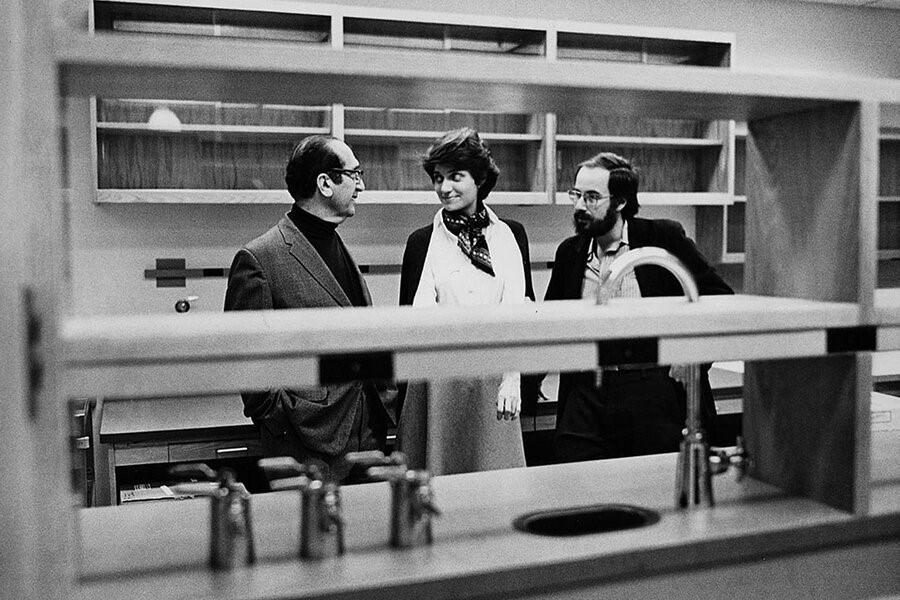REPRINTED WITH PERMISSION FROM THE CHRISTIAN SCIENCE MONITOR
 In 1975, molecular biologist Nancy Hopkins (center) joined the Massachusetts Institute of Technology as an assistant professor. She was the only woman among six initial researchers. Courtesy of MIT Museum
In 1975, molecular biologist Nancy Hopkins (center) joined the Massachusetts Institute of Technology as an assistant professor. She was the only woman among six initial researchers. Courtesy of MIT Museum
May 1, 2023
In 1999, women in science celebrated a major victory when MIT admitted to gender discrimination and became a pacesetter for equality. Kate Zernike recounts the inspiring story in, “The Exceptions: Nancy Hopkins, MIT, and the Fight for Women in Science.”
After Nancy Hopkins became hooked on molecular biology as an undergraduate in the early 1960s, a male postdoc told her, “We’re all curious to know if a girl can make it to the top in science. We think you might be the one.” The two were working in a lab run by James Watson of Watson and Crick, the duo credited with discovering the double helix structure of DNA. Hopkins, a Radcliffe student, had taken a class taught by Watson at Harvard and promptly asked to continue working with him. As Kate Zernike recounts in “The Exceptions: Nancy Hopkins, MIT, and the Fight for Women in Science,” Watson was soon encouraging his acolyte to pursue a Ph.D.
If Hopkins herself was something of an experiment in Watson’s lab, she certainly proved to be a successful one. She went on to earn her doctorate in molecular biology from Harvard and joined the faculty of MIT in 1973, becoming tenured some five years later. Her research initially focused on mapping bacterial viruses and cancer-causing viruses in mice; she later devoted herself to the genetic analysis of zebrafish as a model for understanding early development in vertebrates. Along the way, she attracted grant money, published her results frequently, and enjoyed positive teaching evaluations.
But as New York Times reporter Zernike documents in her meticulous and gripping book, which charts Hopkins’s struggle for equal treatment as a scientist, Hopkins also dealt with a steady stream of indignities, some of which rose to the level of harassment. Her male colleagues sometimes claimed credit for her work and often excluded her from meetings. She was frequently mistaken for a secretary; meanwhile, her own secretary, whom she shared with a male colleague, did the man’s typing first and sometimes didn’t get to Hopkins’s work at all. (“You deserve better than this, Nancy,” the secretary told her.)
She was informed that she couldn’t teach a large lecture class because MIT undergraduates wouldn’t take a woman seriously; instead of being outraged, Zernike writes, she was grateful to the department chair “for sparing her embarrassment.” Men took her equipment and lab samples without permission and encroached on her space. Exasperated, she moved her lab to a more private floor and then was accused of a lack of collegiality.
 CSM"THE EXCEPTIONS: Nancy Hopkins, MIT, and the Fight for Women in Science," By Kate Zernike Scribner, 432 pp.
CSM"THE EXCEPTIONS: Nancy Hopkins, MIT, and the Fight for Women in Science," By Kate Zernike Scribner, 432 pp.
Still, Hopkins continued to believe that science in general and MIT in particular was a meritocracy. She blamed herself for not being comfortable in a competitive, aggressive environment. She resisted thinking that her problems had anything to do with her being a woman.
That began to change in the early 1990s, when her struggle for space and equipment pushed her to a breaking point. She complained to her department chair, who countered that his office was the same size as hers, a claim that Hopkins characterized in her diary as “ridiculous to the point of being crazy.” (She would not have used the term “gaslighting” then, but it comes to mind now.) Ever the scientist, she collected data: She stayed in the building late one night and, tape measure in hand, sneaked into the other offices. It turned out that everyone had more space than Hopkins. The department chair had four times as much, and, as the author writes, “even a junior faculty member – a man – had almost double the space she did.”
She was also galvanized by being told she would no longer be teaching a biology course she herself had developed. She had co-taught the class with a man who was planning to adapt her syllabus into a textbook with her replacement, also a man; the two of them, and not Hopkins, stood to profit financially from her work. In the author’s words, she realized that “these men barely saw her. She was a nonentity.”
Zernike tells this story masterfully. Some of the slights and quarrels she describes might, by themselves, seem trivial, or par for the course in a hard-driving work environment. But they gather undeniable force as they accumulate.
It comes as a relief when Hopkins finally begins to compare notes with other women scientists at MIT (there weren’t many) and finds that she is hardly alone in being, in Zernike’s words, in “a constant battle for resources and recognition.” For months a group of 16 women worked together to craft a proposal for a committee that would investigate the distribution of resources. In 1994, six of them met with Dean of Science Robert Birgeneau, who, hearing their stories, realized with “sudden clarity” that MIT was engaging in a pattern of sex discrimination.
In a satisfying denouement, the university acknowledged its gender bias and set about correcting inequities in salary and recruiting more women to the faculty. The story got out—Zernike was the reporter who wrote the front-page article in the Boston Globe—and “practically overnight,” she writes, “MIT became the pacesetter for promoting gender equality in higher education.”
A number of books have been written about women in science in recent years. These include Margot Lee Shetterly’s “Hidden Figures” and Kathy Kleiman’s “Proving Ground” – which focus on the unheralded accomplishments of women in the early days at NASA and in computer programming, respectively – and planetary scientist Lindy Elkins-Tanton’s memoir, “Portrait of the Scientist as a Young Woman.” While these books tackle discrimination, they are more concerned with celebrating their subjects’ achievements. “The Exceptions,” meanwhile, brings the discrimination to the fore, but in describing the tenacity of Hopkins and her peers, it ends up being just as inspirational.
James Watson remained a lifelong mentor to Hopkins. There’s bitter irony in the fact that the work of a female scientist, Rosalind Franklin, uncredited at the time, is now acknowledged to have been key to Watson and Crick’s Nobel Prize-winning discovery of the double helix. There was never only going to be one “girl” to make it to the top in science. But Hopkins and the other “exceptions” surely helped ease the way for many women to follow.
Related stories
Page created on 5/4/2023 11:53:01 PM
Last edited 5/5/2023 12:00:29 AM
